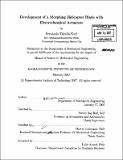Development of a morphing helicopter blade with electrochemical actuators
Author(s)
Tubilla Kuri, Fernando
DownloadFull printable version (16.82Mb)
Other Contributors
Massachusetts Institute of Technology. Dept. of Mechanical Engineering.
Advisor
Steven Ray Hall.
Terms of use
Metadata
Show full item recordAbstract
The use of the expansion of electrochemical cells, upon ion intercalation, for the development of a morphing helicopter blade is explored. Using commercially available lithium-ion batteries as demostrators of the technology, two actuator prototypes suitable for the application are developed. The first prototype consists of a weave of fibers enclosing an array of cells in such a way that the thru-thickness expansion of the cells is transformed into an in-plane contraction. A mathematical model of the actuator is developed and used for the prototype design, which is then implemented using three cells and steel wires. Tests performed on the prototype show that, after accounting for viscoelastic phenomena, the prototype free strain agrees well with the model predictions. A Blade Element Momentum Theory model of the helicopter rotor, used for the design of the second actuator prototype, is described. The model is used for evaluating a morphing scheme in which the blade deforms its trailing edge by different amounts along the span. Under this scheme, a suitable blade twist in terms of forward flight performance can be selected, and the trailing edge deflection is then used to improve the performance in hover. (cont.) Applying the model to a Bell 427 helicopter, it is found that, starting with a blade with 40 less twist than the baseline blade and an expanding cell with an energy per mass of 78 J/kg, it is possible to generate enough flap deflection to improve hovering performance by about 1%, with an actuator that increases the blade mass by less than 10%. The design of a blade actuator based on this trailing edge deflection scheme is then described. It consists of a pair of stacks enclosed inside the blade spar, transferring their motion to the flap via two pushrods and a set of steel flexures. A lumped-parameter model is used for the design and optimization of the actuator, and it is later validated using a finite element software package. Results from the tests on a short scaled section of the morphing blade are presented and compared with the theoretical model.
Description
Thesis (S.M.)--Massachusetts Institute of Technology, Dept. of Mechanical Engineering, 2007. Includes bibliographical references (p. 167-170).
Date issued
2007Department
Massachusetts Institute of Technology. Department of Mechanical EngineeringPublisher
Massachusetts Institute of Technology
Keywords
Mechanical Engineering.